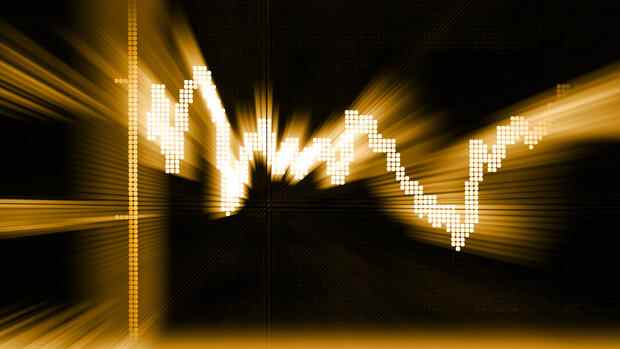Dusseldorf The mood on the German stock market is friendly again, even though the Dax was down 0.1 percent at 14,444 points.
It was gratifying that the so-called “war rates”, the annual low of 13,807 points on the day after President Putin declared war, were no longer reached. Despite the entire trading session, the Dax remained well above the 14,000 point mark.
A look at the Dax chart clearly shows what top, middle and bottom mean for the leading German index in the medium term.
Below is the range between 13,800 and 13,500 points. As long as the regional war in the Ukraine does not spread, this mark should be maintained given the strong willingness of private investors to invest and the high cash ratio of institutional investors.
Other arguments also suggest that the low for the year in the form of 13,807 was reached last Thursday. With almost 220 million Dax40 shares traded, the trading volume was as high as it was last in June 2020. For comparison: In the past four weeks, less than half of the shares were traded per day, around 100 million shares.
Such high trading volume suggests that it was a panic sell-off and the start of bottoming according to sentiment analysis. On this trading day, many investors dumped their stocks on fears of an escalating war scenario. To put it simply: As a result, there are now significantly fewer sellers than buyers.
Above starts at 16,000 points and ends at the previous record high of 16,290 points. An area that seems very far away and currently unreachable.
The focus is on the middle, the area between 14,800 and 15,000 meters. Sustainable prices above 14,800 points would significantly ease the situation on the German stock market. The traffic light, which is currently still red, would then switch to yellow. That shouldn’t be an easy task. A first indication of an increase towards 14,800 points would be prices above 14,586 points, the lowest level before the start of the war.
Stock exchange in Moscow remains closed
Trading on the Moscow Stock Exchange will remain closed this Tuesday. The Central Bank of Russia extended the suspension of trade amid a full-blown financial crisis sparked by Western sanctions. The central bankers want to provide information on the future operation of the Moscow stock exchange on Wednesday before 6 a.m. Central European Time.
After the free fall of the Russian ruble the day before, the situation on the foreign exchange market has calmed down. Initially, the dollar was trading above 101.70 rubles, near the record high seen at the start of the week
110.7745 rubles was reached. Meanwhile, the greenback has given way and is trading at around 90 rubles.
For the Commerzbank foreign exchange analyst Ulrich Leuchtmann, “fundamentally oriented forecasts for Russian assets or the exchange rate no longer make sense, at least for the moment”.
He sees two scenarios: optimists hope for a geopolitical solution, after which the toughest sanctions may be reversed. Pessimists will worry about possible military or other accidents. “If such a scenario were to occur, Russia, like Iran, would remain excluded from the world economy for the next few years,” says the expert.
Oil price is back below $100
Oil prices rose on Tuesday in a tense environment. However, the highs of Monday were not reached. In the morning, a barrel (159 liters) of the North Sea Brent cost 99.91 US dollars. That was $1.79 more than the day before. At the beginning of the week, the price rose well above the $100 mark. A barrel of the US West Texas Intermediate (WTI) variety cost $97.46 on Tuesday, $1.62 more than on Monday.
The triggers for the latest surge in prices on the oil market are Russia’s war in Ukraine and the deteriorating relations between the West and Russia. Commodity experts are dealing with the consequences for Russia’s oil supplies. The country is one of the world’s largest crude oil producers and exporters. The International Energy Agency (IEA) plans to hold an extraordinary meeting on the subject on Tuesday.
“The unstable situation in Ukraine and the financial and energy sanctions against Russia will further fuel the energy crisis and keep oil prices well above $100 a barrel in the short term and even higher if the conflict escalates further,” said Louise Dickson, oil market analyst at Rystad Energy.
Look at the individual values
Covestro: According to the figures, the shares of the plastics manufacturer are up almost five percent. The group more than doubled its operating profit last year to 3.1 billion euros. In addition, Covestro wants to buy back its own shares for up to 500 million euros.
Rheinmetall: The prospect of bubbling profits from higher military spending is once again driving demand for arms companies. Rheinmetall shares are up four percent. At the start of the week they had gained almost 25 percent.
Symrise: The economic recovery from the corona pandemic and strong demand in Latin America are giving the German fragrance and flavor manufacturer a boost. A slightly increased dividend of EUR 1.02 (previously: EUR 0.97) per share is now to be paid out to the shareholders. Shares are up 2 percent.
Here you can go to the page with the Dax course, here you can find the current tops & flops in the Dax.
